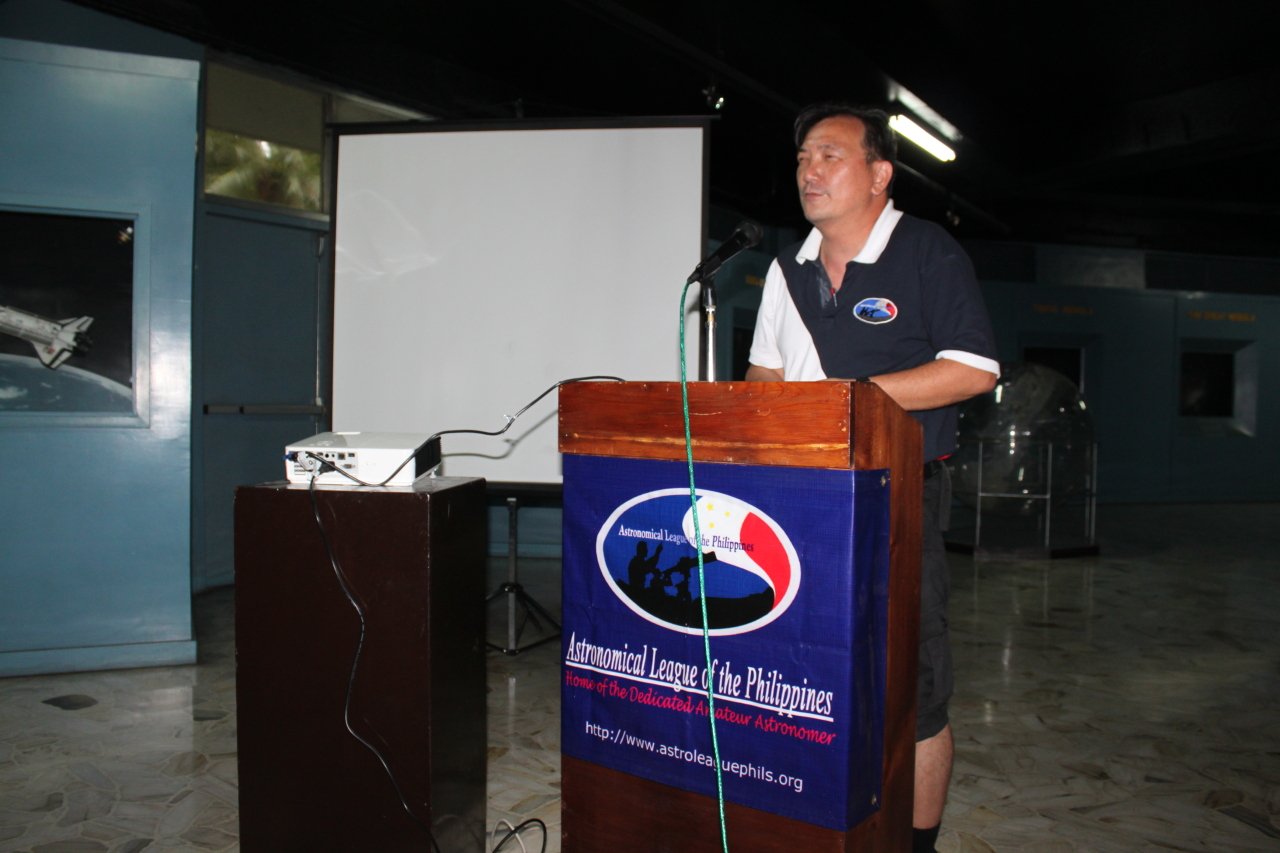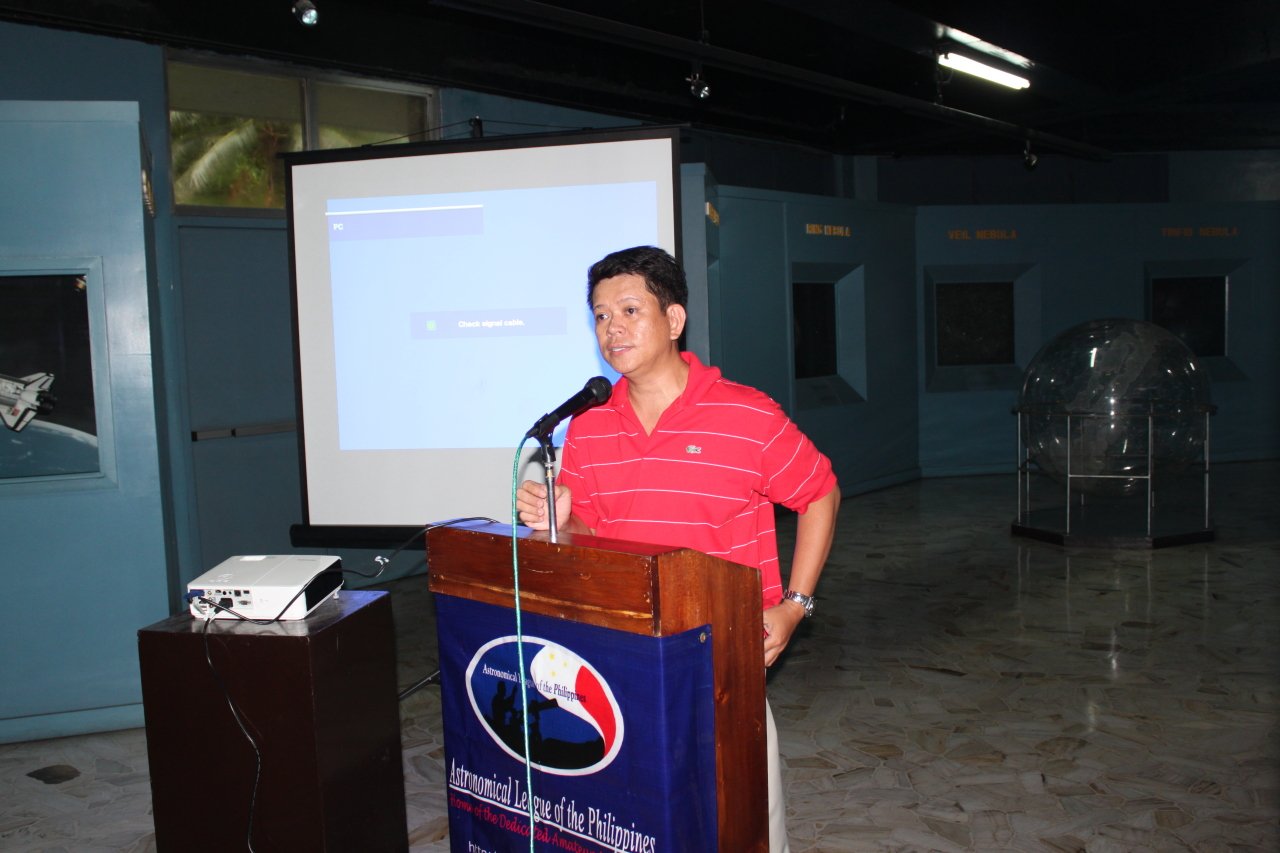May 6, 2012 ALP Monthly
Meeting Report
by James
Kevin Ty
Last May 6,
members of the Astronomical League of the Philippines (ALP) held their monthly meeting at Manila
Planetarium. Members who
attended were ALP President James Kevin Ty , Charito Ty and son Kendrick Cole KC Ty
, VP Jett Aguilar, Secretary Christopher
Louie Lu , Treasurer Andrew Ian Chan and Iah Serna; PRO
Armando Lee with wife Mia and son Jason Lee; director
Edgar Ang, Bel Pabunan, Desiree del Rosario, Norman Marigza, Mike Enage
, Mark Vornhusen, Jan Karlo Hernandez, Arnel Campos,
Vincent Gella, Miguel Enrique Cajita, Ronald Sison with
wife Adriel, children
Adrian, Aleecia and Aldrin.
(ALP) held their monthly meeting at Manila
Planetarium. Members who
attended were ALP President James Kevin Ty , Charito Ty and son Kendrick Cole KC Ty
, VP Jett Aguilar, Secretary Christopher
Louie Lu , Treasurer Andrew Ian Chan and Iah Serna; PRO
Armando Lee with wife Mia and son Jason Lee; director
Edgar Ang, Bel Pabunan, Desiree del Rosario, Norman Marigza, Mike Enage
, Mark Vornhusen, Jan Karlo Hernandez, Arnel Campos,
Vincent Gella, Miguel Enrique Cajita, Ronald Sison with
wife Adriel, children
Adrian, Aleecia and Aldrin.
Meeting proper started at around
3:00pm with ALP Secretary and NAW chairman Christopher
Louie Lu who presented updates on the Large Hadron
Collider. Below is the sypnosis of his lecture:
European Organization for
Nuclear Research (CERN)
CERN is the international
organization that manages, maintain & operates the Large
Hadron Collider (LHC). CERN's member countries are:
Austria,
Belgium,
Bulgaria,
the Czech Republic,
Denmark,
Finland,
France,
Germany, Greece,
Hungary,
Italy,
the Netherlands,
Norway,
Poland,
Portugal,
the Slovak Republic,
Spain,
Sweden,
Switzerland,
the United
Kingdom. Member Countries with
Observer Status:
Turkey, Russia, Japan, United States, India.
Brief History:
December 1949
– French Physicist Louis de Broglie made the first
official proposal for the creation of a European
Laboratory at the European Cultural
Conference in
Lausanne.
June 1950
– American Nobel Laureate & Physicist Isidor Rabi made a
resolution authorizing UNESCO
to “assist &
encourage the formation of research
laboratories in
order to increase international scientific
collaborations” at
the 5th UNESCO General Conference in
Florence.
December 1951
– In Paris, UNESCO held a inter-governmental meeting
where the first resolution for
the establishment
of a European Council for Nuclear
Research was
adopted. 11 European countries
signed the
agreement establishing a provisional council. CERN was
born
October 1952
– During the Councils 3rd
session, Geneva, Switzerland was chosen as the site of
the future laboratory. This site was then ratified in
June 1953.
July 1953
– CERN was ratified by 12 member states: Belgium,
Denmark, France, Federal Republic of Germany, Greece,
Italy, Netherlands, Norway, Sweden, Switzerland,
United Kingdom &
Yugoslavia.
September 29, 1954
– Ratified by France & Germany, the European
Organization for Nuclear Research officially came into
being.
1957
– The first Accelerator built in CERN was a 600 MeV
Synchrocyclotron (SC). It provided CERN's first particle
& nuclear physics
experiments. Until 1964 where it started
to concentrate on
nuclear physics alone. In 1967,
combined with
ISOLDE, SC carried out research ranging
from nuclear
physics to astrophysics & medical physics. In 1990,
SC was shut down after 33 years of service.
November 24, 1959
– The Proton Synchrotron (PS) accelerated particles for
the first time, becoming the highest energy particle
accelerator at the time with a beam energy of 28 GeV. PS
is still in use today as part of a stage to the LHC.
1968
– In the 1960's, particle
detection
normally involves
examining millions of photographs from 'Bubble Chambers'
or
spark Chambers.
Georges Charpak, joined CERN in 1959 & developed the
'Multiwire Proportional Chamber', a gas-filled box with
a large number of parallel detector wires, each
connected to individual amplifiers which is then
connected to
computers that could achieve a counting rate a thousand
times better than the existing detectors. This invention
revolutionized particle detection
which passed the
manual to the electronic
era.
Georges Charpak
was awarded the 1992
Nobel Prize in
physics for his work on
Particle Detector.
1971
– High energy particle collisions previously involves
hitting a stationary target
most of the
valuable projectile energy is taken up by the target
recoil & only a small fraction feeds the collision. But
physicists realize that if two particle beams could be
fired at each other, no recoil energy would be wasted,
making a much
more efficient use
in energy collisions. Thus, the Intersecting Storage
Rings (ISR) was approved for construction in 1965.
300 meters in diameter, the ISR became the precursor for
innovation & technology for future particle
accelerators.
-
New high-vacuum techniques has to be developed.
-
New methods for controlling particle beams mastered.
The ISR produced the
first Proton – Proton collisions on January 27, 1971.
1976
– Measuring 7 km in circumference, the Super Proton
Synchrotron (SPS) was the first of CERN's big rings.
Initially used as a proton accelerator with
a beam energy of
300 GeV, today it operates up to 450 GeV.
Achievements of SPS:
-
Probed the inner structure of protons
-
Investigated natures preference for matter over
anti-matter
-
Looked at matter as it might have been in the first
instant of the universe's life.
-
Searched for exotic forms of matter.
In 1983, Carlo
Rubbia &
Simon van der
Meer, operating the SRS won the Nobel prize for their discovery of W & Z
particles.
February 1985
– Excavations for the Large Electron-Positron (LEP)
collider began with a
27km in
circumference, the ring was completed on 1988.
-
LEP consists of 5176 magnets and 128 accelerating
cavities with a initial beam
energyof
100 GeV.
-
It was later upgraded to have 288 superconducting
accelerating cavities to double this energy.
- Along its
ring are 4 enormous detectors, ALEPH,
DELPHI, L3 & OPAL.
- Its
experiments provided a detailed study of the electroweak
force interactions.
-
Its experiments also proved that there are three, and
only three, generations of particles of matter.
The LEP served 11 years
in Particle & Nuclear research. On
November 2, 2000,
it was closed down to make way for the construction of
the Large Hadron Collider (LHC)
Large
Hadron Collider (LHC)
This is the largest and
most powerful particle accelerator/collider in the
world. With a circumference of 27km, the LHC is found
within the border of France and Geneva, Switzerland.
Number of Magnets: 9593, Number of
dipoles: 1232,
Number of quadrupoles:
392. Average depth: 100m,
Lowest depth:
150m.
Experiments: ATLAS,
ALICE, CMS & LHCb
ATLAS (A
large Toroidal LHC ApparatuS - ATLAS is a
general‑purpose detector designed to cover the widest
possible range of physics at the LHC, from the search
for the Higgs boson to supersymmetry (SUSY) and extra
dimensions.
ALICE (A
Large Ion Collider Experiment) - ALICE is a detector
specialized in analyzing lead-ion collisions. It will
study the properties of quark-gluon plasma, a state of
matter where quarks and gluons, under conditions of very
high temperatures and densities, are no longer confined
inside hadrons.
CMS
(Compact Muon Solenoid) - CMS is a general‑purpose
detector with the same physics goals as ATLAS, but
different technical solutions and design.
LHCb
(Large Hadron Collider beauty) - LHCb specializes in
the study of the slight asymmetry between matter and
antimatter present in interactions of B-particles.
Understanding it should prove invaluable in answering
the question: “Why is our Universe made of the matter we
observe?”
What is the Goal?
1.)
Finding the
Higgs-Boson partivcle
2.)
Further understanding the unification of the 4
fundamental forces.
3.)
Understanding and further discovery of Dark Matter and
Dark Energy.
4.)
The LHC will help us understand why we live in a
universe with more matter rather than antimatter.
5.)
Give us a glimpse of the state of matter during the
first moments after the Big Bang, known as 'Quark-Gluon
Plasma'.
LHC updates:
1.)
Faster-than-light Neutrinos
2.) LHC to undergo upgrade &
facelift..
3.) Closing in on the Higgs.
4.) Ramping up the speed.

ALP Secretary Christopher
Louie Lu discussed on the latest updates on CERN as
well as Hadron Large Collider. |

ALP VP Jett Aguilar discussed
on the upcoming May 21, 2012 Annular Solar Eclipse
(Partial Solar Eclipse in the Philippines) and June
6, 2012 Venus Transit. |

ALP President James Kevin Ty
added experience info on what to expect if one will
travel to the annular eclipse path to observe the
annular eclipse based from his August 1998 annular
solar eclipse experience in Malaysia as well as
announced the different ALP eclipse teams set up for
the May 21 event. |

ALP PRO Armando Lee will head
the Philippine eclipse teams set up at different
sites. He will also do live webcasting of the
eclipse event. |
Afterwards, ALP VP Jett Aguilar
presented a detailed summary of the upcoming May 21
annular solar eclipse (partial solar eclipse in the
Philippines). The event will start at sunrise with
the eclipse already started more or less 30 minutes
already and will reach around 61.5% eclipse at maximum
time of around 5:59am in Manila. He also discussed
the June 6 Venus transit event which will be the
last one for our lifetime to observe this century.
He describe what's
the best site for one to observe the eclipse and transit
here in the country as well as safety precaution in
observing the events. The use of a safe solar
filter is recommended to observe the events
properly.
ALP President James Kevin Ty then
announce the ALP eclipse teams that are formed.
Xiamen, China team consisting of James Kevin Ty,
Jett Aguilar and Mark Vornhusen ; Cedar Break , Utah
team consisting of Christopher Go and Jun Lao ;
Alburqueque , New Mexico headed by Eric Africa and
last but not the least the Philippine team consisting of
observation sites in Manila Planetarium, AstroCamp
Observatory and another undisclosed site that will be
participated by numerous ALPers. Aside from
observing and imaging the event, they also have plans to
do live webcast of the event via twitter. Lastly,
ALP PRO Armando Lee will head the local eclipse team
here to coordinate the local observation site here,
Meeting ended at around 5:30pm.
|